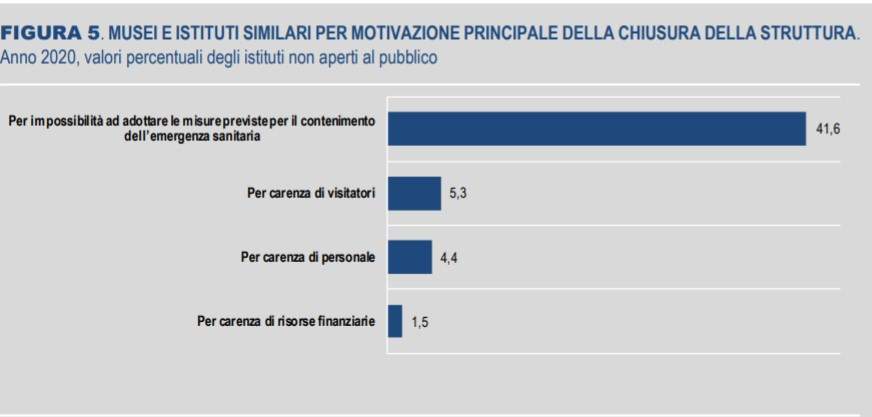Istat, Museums 2020: 8% did not reopen after forced closure. Here are the reasons
According to Istat’s latest report on museums, eight out of 100 museum venues have not reopened after the physical closure imposed in March 2020. Specifically, it says, “2 percent of facilities continued to perform only routine administrative, research and communication functions, but did not reopen their exhibition spaces to public visitation, while 6 percent suspended all activities, including those of museum management and administrative organization.”
The interruption of in-person visits was due for the majority of these institutions (41.6 percent) “because they could not take sanitary measures to reduce the risks of infection in the exhibition spaces; for one in 10 museums (11.2 percent) the failure to open to the public is closely linked to the lack of adequate staff and economic resources to comply with the measures provided for the containment of the pandemic.”
“Among inactive museums,” the report continues, “the majority are publicly owned (62.2 percent), particularly by local authorities (49.3 percent), or located in small urban centers with up to 5,000 inhabitants (45.5 percent) or in sparsely populated rural areas (45.7 percent). More than half of these institutions are located in the North (53.7 percent) especially in Piedmont and Lombardy. Facilities that seem to have been most affected by the closure to contain the pandemic include museums of history and natural sciences (19.7 percent), museums displaying ethno-anthropological material (16.7 percent) and art museums (13.5 percent).”
Regarding online activities, during the period of suspension of physical public access, “35.8 percent managed to ensure online activities and services, activating or increasing their presence both on the main social media, such as Facebook, Instagram, Twitter (24 percent), and on dedicated web platforms (18.5 percent). Some have organized themselves by promoting and developing remote audience interaction and engagement projects and activities, through offering, for example, video interviews, in-depth coverage of collections and meetings with industry experts in live streaming (12.9%).”
“Only 22 percent,” the report concludes, “reopened their exhibition spaces to the public as early as early 2021; of the remaining 78 percent, one-half planned to reactivate visitor services by the end of 2021, while the other half could not indicate if and when they would open to the public again.”
Istat also stated that “in 2020, the Italian museum sector mobilized a total of nearly 48,000 workers including employees, consultants, external staff and volunteers; an average of 11 people for each facility surveyed. 68.4 percent of institutions have no more than ten staff, 26.8 percent from eleven to twenty. Employees from outside companies and entities (e.g., staff for ticketing, cleaning or security services) numbered nearly 9 thousand, an average of two per institution. The contribution of volunteers, interns and trainees was important: more than 14 thousand, an average of four per exhibition facility. Twelve percent of the museums are staffed entirely by volunteers working for free; more than half have municipal ownership (52.2 percent).”
 |
| Istat, Museums 2020: 8% did not reopen after forced closure. Here are the reasons |
Warning: the translation into English of the original Italian article was created using automatic tools. We undertake to review all articles, but we do not guarantee the total absence of inaccuracies in the translation due to the program. You can find the original by clicking on the ITA button. If you find any mistake,please contact us.




























